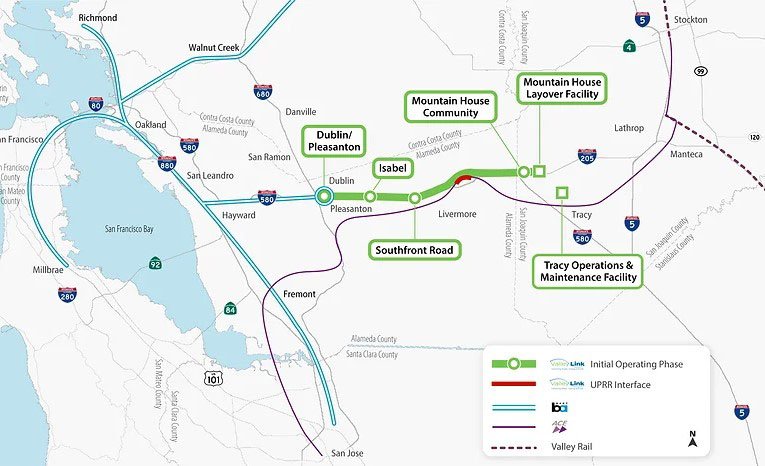Valley Link — when the first commuter trains start rolling as early as 2027 — will be more than just the second commuter rail line crossing the Altamont Pass.
It will also be the first passenger rail system in the nation powered using self-produced green hydrogen fuel provided by a proposed 200-acre Tracy production facility.
“Today there is no clean, reliable, high frequency transit alternative to vehicular congestion on Interstates 205 and 580 for the more than 105,000 Bay Area workers now commuting daily from their homes in communities in the Northern San Joaquin Valley,” noted Melissa Hernandez, BART Director and Chair of the Valley Link Board of Directors.
Hernadez made her remarks during a lunch-and-learn event at the Tracy Community Center on Wednesday.
The hydrogen fuel plant will also support the clean energy goals of other transit and heavy truck operators.
Funding has been identified for the first 22-mile phase connecting the Dublin/Pleasanton BART station to Mountain House. near the Interstate 205 corridor.
It will include station stops at Isabel Avenue and Southfront Road in Livermore.
The eventual plan is to extend Valley Link from Mountain House to the Lathrop transfer facility being built in Lathrop off of Lathrop Road within a half mile of Manteca’s northwest city limits.
At that point, it would connect with ACE trains initially running through Manteca and Ripon from Ceres to Sacramento. Evetually, ACE will connect with high speed rail in Merced.
The second phase of Valley Link would include stops in River Islands and Tracy.
The initial phase is now under environmental review.
The target to begin the final engineering and design later his year with construction possibly starting in 2026.
The $1.86 billion first phase could be operating as early as 2027.
Valley Link is designed to run trains every 15 minutes during peak commuter times.
That makes it a game changer given ACE service is only one way in the morning and one way in the afternoon.
ACE will also connect with Valley Link in Livermore.
Marcel also noted at Wednesday’s gathering that the City of Tracy and neighboring communities on both sides of the Altamont Pass in San Joaquin County and the Tri-Valley will reap the benefits of job creation and economic growth, with the City of Tracy serving as the epicenter due to the location of the hydrogen fuel production facility.
“Even before Valley Link begins operations, the hydrogen production facility will support clean energy for Livermore Amador Valley Transit Authority and other transit operators within the next 2 to 3 years, providing a near-immediate benefit to the community,” she said.
To date, the state has invested in a number of hydrogen vehicle technologies and several transit agencies in California are producing their own hydrogen fuel.
The sustainability vision of the Valley Link rail project seeks to significantly expand on this concept including the opportunity to manage risk and maximize the outcomes of green hydrogen production through public-private partnership with expertise from the hydrogen production industry.
Alameda County District 1 Supervisor, David Haubert stated, “The Valley Link hydrogen production business model is intended to serve as not only a catalyst for private investment, but also for a green energy economy within the Northern California megaregion combined with workforce development to create and sustain living wage jobs."
To contact Dennis Wyatt, email dwyatt@mantecabulletin.com









